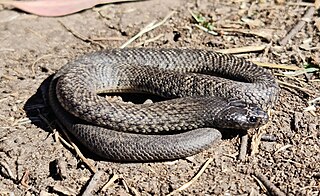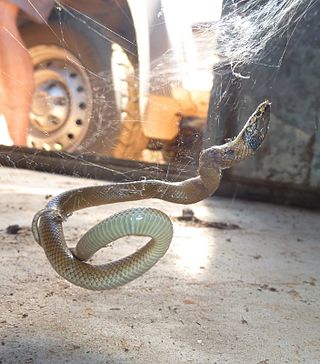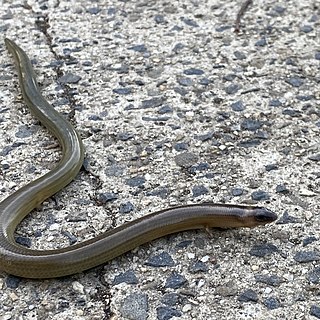
Anomalopus is a genus of worm-skinks, smallish smooth-scaled burrowing lizards in the family Scincidae. The genus is endemic to the eastern half of Australia. The genus belongs to a clade in the Sphenomorphus group which contains such genera as Ctenotus and the close relatives Eulamprus and Gnypetoscincus.

The eastern brown snake, often referred to as the common brown snake, is a species of extremely venomous snake in the family Elapidae. The species is native to eastern and central Australia and southern New Guinea. It was first described by André Marie Constant Duméril, Gabriel Bibron, and Auguste Duméril in 1854. The adult eastern brown snake has a slender build and can grow to 2 m (7 ft) in length. The colour of its surface ranges from pale brown to black, while its underside is pale cream-yellow, often with orange or grey splotches. The eastern brown snake is found in most habitats except dense forests, often in farmland and on the outskirts of urban areas, as such places are populated by its main prey, the house mouse. The species is oviparous. The International Union for Conservation of Nature classifies the snake as a least-concern species, though its status in New Guinea is unclear.

Pseudonaja is a genus of highly venomous elapid snakes native to Australia. Species of this genus are known commonly as brown snakes and are considered to be some of the most dangerous snakes in the world; even young snakes are capable of delivering a fatal envenomation to a human.
Drysdalia is a genus of snakes, commonly known as crowned snakes, belonging to the family Elapidae. The three species in this genus are venomous snakes, but not considered deadly.

The broad-headed snake is a species of venomous snake in the family Elapidae. The species is restricted to the Sydney Basin in New South Wales, Australia. It is one of three snakes in the genus Hoplocephalus, all restricted to eastern Australia. It is currently endangered in New South Wales and is listed as vulnerable under the Commonwealth Legislation.

The white-lipped snake is a small species of venomous snake in the family Elapidae. The species is endemic to south-eastern mainland Australia and Tasmania.
Dunmall's snake is a species of venomous snake in the family Elapidae. The species is endemic to Australia.

The blue-bellied black snake, also known commonly as the spotted black snake, is a species of venomous snake in the family Elapidae. The species is native to Australia.

Suta is a genus of venomous snakes in the family Elapidae. The genus is endemic to mainland Australia.

The golden-crowned snake is a small species of venomous snake in the family Elapidae. The species is endemic to Australia.
Hemiaspis damelii is a species of venomous snake in the family Elapidae. It is a relatively small species of elapid with a mean snout-vent length (SVL) of 42.6 to 60 cm. The species is endemic to eastern Australia and is most commonly found across central inland New South Wales through to the interior of south-eastern Queensland. Common names for this species include ngabi, grey snake and Dämel's Snake. The specific name, damelii, is in honor of German entomologist Edward Dämel, who collected Australian specimens for Museum Godeffroy.

The western brown snake is commonly known as Mengden's brown snake, and alternatively, gwardar.
Cacophis krefftii is a species of venomous snake in the family Elapidae. The species is endemic to Australia.
The eastern dwarf mulga snake, also known commonly as the eastern pygmy mulga snake and the false king brown snake, is a species of venomous snake in the family Elapidae. The species, which is native to Australia, was genetically confirmed as a distinct species in 2017.

The little whip snake, also known commonly as the whip hooded snake, is a species of venomous snake in the family Elapidae. The species is endemic to Australia.

The spectacled hooded snake, also known commonly as the Port Lincoln snake, is a species of venomous snake in the family Elapidae. The species is native to central-southern Australia. There are three recognized subspecies.

Anomalopus verreauxii, also known commonly as the three-clawed worm-skink or Verreaux's skink, is a species of lizard in the family Scincidae. The species is endemic to Australia.

Brachyurophis australis(coral snake) is a species of snake from the family Elapidae (common names - eastern shovel-nosed snake, coral snake, Australian coral snake) and is a species endemic to Australia. Its common name reflects its shovel nose specialisation.
The pale-headed snake is a species of venomous snake in the family Elapidae. The species is endemic to Australia.
Cacophis harriettae, also known commonly as Harriett's snake, the white-crowned snake, and the white-naped snake, is a species of mildly venomous snake in the family Elapidae. The species is endemic to Australia.













